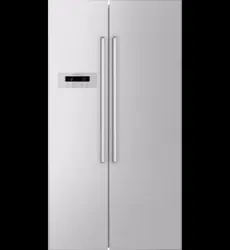Loading ...
Loading ...
Loading ...

Installing your new refrigerator Using your refrigerator
Kelvinator Refrigeration Installing your new refrigerator 5
5. If the refrigerator now rocks from one corner to the opposite
rear corner, this means that the floor is uneven; you will need to
put some packing under one of the rear rollers. You could use
thin pieces of solid material, such as thin board, vinyl floor tiles
or laminate. Place the packing so that it will sit under one of the
rear rollers when the refrigerator is rolled into position.
6. You may now need to fine-tune the installation by repeating
Steps 3, 4 and 5.
7. Whenever you need to move the refrigerator, be sure to wind
the foot back up so that the refrigerator can roll freely.
8. Clean your refrigerator thoroughly following the instructions
on page 9 and wipe off any dust that has accumulated during
shipping.
9. Plug the refrigerator into the power point. Don’t use a double
adaptor. If you need to roll the refrigerator out to get at the
power point, remember to raise the stability foot before you
do so.
10. We recommend that you let your refrigerator run for two
to three hours before you put any food in it. This will allow
you to check that it is operating properly.
Fitting the handles
To install the handle, insert the handle into the holes in the door
(direction 1), then pull down in direction 2.
To remove pull up then off.
1
2
Your new refrigerator has been supplied with protective plastic film
on the doors and cabinet, you can choose to remove this film as
needed.
Congratulations! You have successfully installed your
new refrigerator.
caution
Keep ventilation openings, in the appliance enclosure
or in the built-in structure clear of obstruction.
Refrigerator Operation
The refrigerator transfers heat from food placed inside the
appliance to the outside air.
This process makes the rear, the sides and the area adjacent to
the doors, particularly at initial start up, feel warm to hot, this is
normal.
There is a cooling coil located behind the rear wall of the cabinet.
This coil cools and removes moisture from the air. A fan then
circulates cold, dry air throughout the cabinet.
This air circulation means that foods are refrigerated far more
quickly than in refrigerators where the air remains relatively static.
Avoid placing food against air outlets as this will affect
air circulation.
A light frosting will occasionally occur on the cold interior of
the freezer when the door is opened frequently. This is normal
and will disappear after a few days in most climates.
Make sure you fully close the freezer door after you load or remove
food. If the door is left partly open, a heavy frost will coat the
inside of the freezer. If a frost develops, remove it. Take care to
properly close the door and the frost will not reoccur.
Your new energy efficient appliance uses a high-speed compressor
and other energy efficient components that may produce different
noises to your old appliance.
These sounds are normal and include:
• compressor running noise.
• air movement noise from the small fan motor.
• occasional gurgling, similar to water boiling.
• a popping noise, heard during automatic defrosting.
• a clicking noise, just prior to the compressor starting up.
These noises are normal and not cause for alarm.
Temperature Control
The factory default settings are;
Refrigerator 5°C
Freezer -18°C
If you want to change the temperature, follow the instructions in
the section about the user interface for your model. Ensure that you
make only small adjustments and wait 24 hours to see if it’s correct to
your liking.
Note: When you set a temperature, you set an average temperature
for the whole refrigerator cabinet.
Checking the softness of ice cream is a good indication that your
freezer is the right temperature, while checking the temperature
of water kept in the refrigerator is a good way of checking the
temperature of the food compartment.
Temperatures inside each compartment may vary, depending on how
much food you store and where you place it.
High or low room temperature may also affect the actual temperature
inside the refrigerator.
Loading ...
Loading ...
Loading ...
